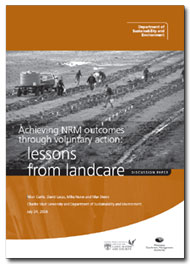Achieving NRM outcomes through voluntary action: lessons from landcare

Victorian Department of Sustainability and Environment Discussion Paper.
Allan Curtis, David Lucas, Mike Nurse and Max Skeen.
Charles Sturt University and Department of Sustainability and Environment July 24, 2008
Introduction
Natural Resource Management (NRM) in Australia is characterised by complex issues that occur at landscape scales. The causes and solutions are uncertain and require long-term commitment, and no one organisation has the capacity to secure desired changes. A relatively small tax base and a large urban population, increasingly disconnected from rural and natural environments, have also constrained remediation efforts. Governments have invoked a variety of policy instruments, but there has been heavy reliance on the actions of private landholders and other volunteers to achieve NRM outcomes.
In recent years there has been widespread acceptance of the need to effect change at the landscape scale, adopt integrated approaches and to invest limited resources more strategically to protect key assets. For example, in Victoria, the Land Asset Framework and Ecosystem Services approach from the Millennium Ecosystem Assessment (MEA) underpins government programs employing a range of policy instruments to address the causes of degradation. The move to regional planning and delivery of NRM programs was expected to enhance the goals of integration and strategic investments.
There has also been greater willingness to employ a range of policy instruments, including:
- legislation
- research and development
- taxation rebates and incentives
- direct purchases of land and water entitlements
- the development of economic instruments to engage landholders.
Nevertheless, the voluntary work of landholders and conservation volunteers has remained critical to the achievement of NRM objectives. The formation of networks of volunteer groups, usually in partnership with government and industry groups, has been an important development assisting integration and the scaling-up of NRM interventions.
Over time there has been increased focus on identifying the outcomes of NRM investments.
For example, successive Australian National Audit Office (ANAO) evaluations of major national NRM programs have criticised the limited attention given to monitoring and evaluation and the lack of credible evidence of investment leading to NRM outcomes,
particularly improved resource condition.
This paper summarises the value-proposition for ongoing investment in voluntary approaches that deliver NRM outcomes. We will draw on the Victorian experience with landcare since 1986 to address questions about the outcomes of previous investments
in voluntary action and the future roles for voluntary approaches to NRM. In doing this, we will articulate and critically review the logic of community landcare in
Australia
| Attachment | Size |
|---|---|
| 1.19 MB |

